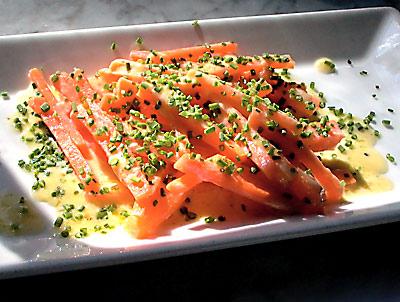Seasons by the Sea: Vegetable Virtuosity

Chances are, the last time you bit into a sweet, buttery ear of corn was five or six months ago. Wasn’t it delicious? Your last fully ripe, deeply red tomato salad scattered with herbs followed by a perfect local peach? Seems like such a long time ago.
Perhaps you have been perusing seed catalogs, dreaming about next summer’s garden. When you go grocery shopping this time of year, do you look at the produce section and go . . . “Meh”?
Do not despair; this is the perfect time to expand your vegetable repertory. There are plenty of interesting root vegetables, alliums, and cruciferous vegetables that take well to wintertime cooking. Stews, ragouts, and warm salads made entirely with vegetables or with just a bit of meat or fish added are a welcome change this chilly time of year.
I like to mix potatoes with celery root in a purée or gratin. Brussels sprouts roasted or shredded and pan-fried with a bit of crisped pancetta make a wonderful winter side dish. I had it last night! Endive is delicious in small doses in a salad, but try it in the classic French style, braised whole and perhaps topped with toasted breadcrumbs or grated cheese. This is also a good time to try those peculiar vegetables that baffle us, the ones hidden around the corner of the I.G.A., chayote, plantains, and spaghetti squash.
Carrots are good all year round as is broccoli raab. Try the carrots blanched, then sautéed with a bit of butter and topped with minced chives. Broccoli raab cooked with a few ounces of hot Italian sausage mixed with orecchiette is an economical and hearty one-dish meal.
It’s also okay to dabble with canned and frozen vegetables. Artichoke hearts, hearts of palm, olives, lima beans, and black-eyed peas can be incorporated into casseroles and salads.
Plant foods can provide you with all the nourishment you need to live and thrive. Our primitive ancestors started out eating little else, and many cultures still do. For most of the 20th century nutritional science aimed to define an “adequate” diet, and determined our “minimal” requirements for balance. More recently, nutritional science is focused on defining the “optimal” diet. After comparing health statistics from around the world, people now realize that plants are the planet’s biochemical virtuosos!
Beets belong to the goosefoot family, and their closest relatives, chard and spinach, are cultivated for their leafy greens. Beets have a remarkably high sugar content, which makes them delicious when roasted with other root vegetables, such as parsnips and celery root. They are also divine pickled and served with prosciutto and patés.
Broccoli is related to kohlrabi, cauliflower, Brussels sprouts, and kale. Broccoli raab is more closely related to the turnip. Look for heads of broccoli that are firm and bright green, any yellowing or tiny yellow flower buds are a sign of age and poor quality. With broccoli raab, choose tender fleshy stems with the flower heads still closed.
Carrots, which are closely related to parsley and fennel, contribute a sweet, rich character to stocks, marinades, soups, and sauces. But they shine best when cooked alone or with a few other vegetables. Look for firm, crisp carrots with smooth, unblemished skin, avoid those with soft or discolored spots. If tops are still attached, they should be bright green and not wilted.
Both celery and celery root have strong herbaceous flavors. Originally, celery was considered useful only for medicinal purposes. Celery root, the milder of the two, is delicious raw in a mustardy vinaigrette or cooked with other cold season vegetables like chestnuts, fennel, and artichokes.
There is a great variety of winter squashes available, butternut, acorn, Delicata, Hubbard, and Kabocha. They can be diced and sautéed, made into soups or gratins, simmered in chicken stock with onions, flavored with bacon, mixed into a risotto . . . the possibilities are endless.
Of tropical origin, the sweet potato develops more sweetness and flavor while in storage, making it another ideal winter vegetable. I buy quite a few at a time, bake them all, and figure out what to do with them the rest of the week.
Sometimes in restaurants I order two vegetable side dishes and a salad instead of the usual appetizer and entree. I have found out that an imaginative selection of side dishes reflects creativity in the kitchen.
So we all miss those fleeting treats of summer. They are still five or six months away from us. In the meantime, why not explore the everyday and the more unusual vegetables of winter?
Click For Recipes
